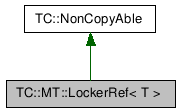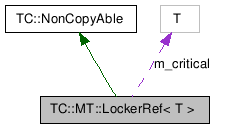TC::MT::LockerRef< T > Class Template Reference
[Multithreading]
Automatic locking class for references Class for automatic locking of a critical objects (like TC::MT::Mutex,TC::MT::ClassLevelLockable, TC::MT::ObjectLevelLockable.
More...
#include <TCMTLock.h>


Public Member Functions | |
| LockerRef (T &critical) | |
| Constructs a Locker object. | |
| ~LockerRef () | |
| Destructs the Locker object and unlocks the critical section associated with this object. | |
Private Attributes | |
| T & | m_critical |
| Reference to the critical section used by this object. | |
Detailed Description
template<class T>
class TC::MT::LockerRef< T >
Automatic locking class for references Class for automatic locking of a critical objects (like TC::MT::Mutex,TC::MT::ClassLevelLockable, TC::MT::ObjectLevelLockable.
..). The class has to provide the methods Lock and UnLock
When constructing a Locker it automatically locks the critical object. This can be used when you have a methode which locks a critical object on enter and UnLocks it when leaving a method.
As an alternative to:
void Test()
{
critical.Lock();
.....
.....
.....
critical.UnLock();
}
you can use a single instance of the Locker class:
void Test()
{
TCMT::Locker<type> lock(critical);
....
....
....
}
This has the advantage that critical.UnLock() will be called automatically when an exception is thrown or the method is left.
Definition at line 95 of file TCMTLock.h.
Constructor & Destructor Documentation
| TC::MT::LockerRef< T >::LockerRef | ( | T & | critical | ) | [inline] |
Constructs a Locker object.
The critical object is automatically locked.
- Parameters:
-
critical The reference of the object locked by this constructor.
Definition at line 104 of file TCMTLock.h.
References TC::MT::LockerRef< T >::m_critical.
| TC::MT::LockerRef< T >::~LockerRef | ( | ) | [inline] |
Destructs the Locker object and unlocks the critical section associated with this object.
Definition at line 114 of file TCMTLock.h.
References TC::MT::LockerRef< T >::m_critical.
Member Data Documentation
T& TC::MT::LockerRef< T >::m_critical [private] |
Reference to the critical section used by this object.
Definition at line 121 of file TCMTLock.h.
Referenced by TC::MT::LockerRef< T >::LockerRef(), and TC::MT::LockerRef< T >::~LockerRef().
The documentation for this class was generated from the following file: